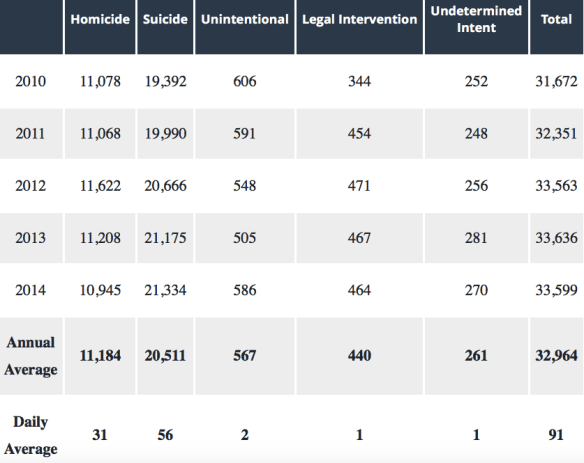by
J.C. Schildbach, LMHC
There is absolutely nothing controversial about Hillary Clinton’s claim that, in the United States, “We have 33,000 people a year who die from guns”–except maybe to those who don’t understand how words and numbers work.
Yet, AWR Hawkins, breitbart.com’s “Second Amendment Columnist,” posted a “Fact-Check” column, titled “No, 33,000 Not Killed with Guns Each Year” following the third presidential debate, claiming that Clinton deliberately inflated the CDC numbers of firearm deaths by adding in suicides. This is not the first time Hawkins has posted similar complaints.
What Hawkins fails to do is explain how suicides by firearm somehow fall outside of the “33,000 people a year who die from guns.” Certainly, Hawkins must understand that somebody who uses a gun to kill him/herself is dead, and did use a gun in order to die—making that person someone who ‘died from a gun.’
Using Hawkins’ preferred language of people “killed with guns each year” still doesn’t change anything. A person who commits suicide with a firearm still was, in fact, killed with a gun.

Hawkins also strikes out by putting the phrase “gun violence” in quotation marks, saying that the use of that phrase (which Clinton did not use in the quote he complains about) somehow plays into Clinton’s strategy of fooling the public. But, again, killing oneself with a firearm does qualify as “gun violence”–first of all, because it involves an act of violence; and secondly, because it involves a gun. Or you can reverse that so the gun is first and the violence is second—still doesn’t change anything.
I don’t want to get into speculation about things that Clinton didn’t say, but perhaps if she had used the phrase “gun crimes” or had referred to murders using guns, then Hawkins would have a better argument. But Clinton didn’t. So Hawkins doesn’t.
And, in case you’re wondering, the 33,000 figure is dead-on. Here’s a chart, showing the CDC numbers of gun deaths for the years 2010 to 2014 (2014 being the most recent year statistics are available) clearly showing that gun deaths have reached well above 33,000 per year for 2012, 2013, and 2014, and averaged 32,964 per year for the five-year period.

- A handy chart of CDC statistics on gun deaths, lifted from Everytown for Gun Safety at https://everytownresearch.org/gun-violence-by-the-numbers/
Now, I get that gun-loving Americans, including the Breitbart crowd, don’t like to believe anything negative about guns. They also don’t like to believe that they may, at some point, end up so distraught, or so deep in the throes of mental illness, that they might use their guns on themselves, and/or their family members or other loved ones—or perhaps even neighbors or random strangers.
By pushing the suicide statistics aside, or pretending they ‘don’t count’, Hawkins ignores a harsh reality here: that people who own guns tend to kill themselves with those guns far more than they kill an intruder in their home, or otherwise defend themselves from the big, bad, scary world out there. People who own guns kill themselves with those guns more often than criminals use guns to kill innocent citizens; and more frequently than ‘gang violence’ leads to gun deaths.
There is also considerable overlap in the “murder/suicide” category—where gun owners kill their significant others, family members, co-workers, or random strangers, prior to turning their guns on themselves. And because guns are such a quick and effective killing tool, the decision to use them in an act of violence on loved ones or oneself is often impulsive—a few too many bad days in a row, a bad argument following a few too many beers, or even a partner deciding they want out of a relationship, and the gun comes out as the ultimate way to put a stop to whatever is so aggravating.
As for mental illness, Hawkins’ argument becomes even less convincing in the face of all the clamoring about how we don’t have a gun problem in the U.S., but we have a mental health problem. Of course, people who make such an argument are usually talking about the mental health issues of mass shooters. Yet, if we (properly) view suicide as a mental health issue, then the numbers of firearm suicides become that much more disturbing. Gun owners kill themselves at a rate roughly twice as high as the rate of gun murders. That’s a vast mental health issue that’s not being addressed, and that is being exacerbated by guns.
Yes, I know that many of the people who want to argue in favor of guns like to point out that people who commit suicide will find the means to do so, even if you take their guns away–an argument which is demonstrably false in terms of overall lethality. There are many ways to map out the evidence showing this falsehood, including the high rate of suicide by firearm–roughly 50% of all suicides in the U.S. are completed using guns. Another way to conceptualize the difference in suicide methods is to compare suicide completion rates using firearms relative to suicide completion rates using other methods. For instance, plenty more people survive suicide attempts by overdosing on pills than survive suicide attempts using guns.
Those who are willing to brush off the connection between firearms and suicide also sometimes argue that suicide is a matter of personal freedom—of being allowed to end one’s life when one chooses. I will say that I’m not completely opposed to people being able to end their own lives on terms they choose. However, I’ve learned enough to know that people are least equipped to make that decision quickly, impulsively, or while in a deep depression (among many other factors). Very few people attempt suicide while they are thinking in the clearest of terms, or making a rational decision based on a comprehensive review of the facts.
Depression and many other forms of mental illness are notorious for their association with cognitive distortions, aka, “thinking errors”—misinterpreting the world around one, the impact one’s actions have on others, and the view other people have of one (again, among many other factors). As I’ve pointed out before, the idea that a gun keeps one safe is, itself, a cognitive distortion. The suicide-by-firearm statistics make that clear.
There is also, perhaps, a great irony here, in that Hawkins believes he is advocating for gun ownership, when the “mental health” approach to suicide prevention involves removing the means for suicide. That is, safety planning for suicide prevention involves taking away those means most likely to be used in a suicide attempt, while the person at risk for suicide gets treatment.
So, how do we address the mental health problems associated with guns and suicide? Take the guns away, at least until the person moves beyond risk for suicide. Of course, mental health treatment is not predictive. Risk factors can be weighed, and support systems assessed, but given the ease with which a person can use a gun to end her/his own life, a dip back into depression, a few more bad days, a drift away from regular engagement with one’s (positive) coping skills, and the risk can escalate once again.
Hawkins thinks he is supporting gun rights by poo-pooing the statistics on firearm deaths in the United States. But what he is actually doing is pointing out that suicide is twice as big a problem, where guns are concerned, as murder is. His solution is to pretend the people who commit suicide with guns aren’t really people who “die from guns.”
At base, he is arguing that people who commit suicide with guns aren’t really people…or perhaps aren’t really people who deserve the support to go on living.
